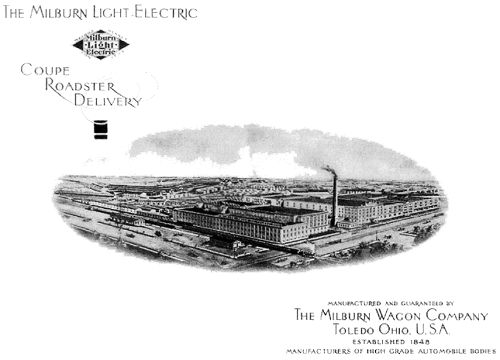The Milburn Wagon Company knew a thing or two about large-scale production. George Milburn was born in Alston, Cumbria, in 1820. He emigrated to Canada before moving across the border to the United States of America in 1835. A successful businessman who owned hotels and property, George started the Milburn Wagon Company to manufacturer farm wagons. The Milburn factory, in Toledo, Ohio, was a marvel of modern technology, boasting a level of mechanized production previously unheard of and making the company the largest farm-wagon manufacturer in the world by 1875.
After George died in 1883, the company diversified into building car bodies, including some for the Ohio Electric car company, which mainly sold upmarket brougham carriages. When merger talks between the two companies fell through, Milburn decided to enter the fray as a manufacturer in its own right. However, it would do so with a cutprice electric vehicle aimed at would-be motorists of more modest means manufactured using know-how gained in the wagon building business.
The 1915 Milburn Light Electric (painted Milburn Blue unless made to special order) was based on a design by Karl Probst, the freelance engineer and automotive enthusiast who is best known for creating the iconic Jeep in 1940. It was lighter than the competition at 2,100 lb (952 kg) (the company’s motto was ‘weighs nearly a ton less’ than the competition) and simpler. Many of the key components were manufactured by contractors (the motor and controller were both made by General Electric) with final assembly and testing taking place at the company’s car plant. The first Milburn had a top speed of 15 mph (24 kmh), or 19 mph (30 km) as a roadster, and a claimed range of 50miles (80km). By the following year the roadster version was priced at $1,285, making it comfortably the cheapest electric car on the market, albeit still three times the price of a Model T.

Milburn continued to extend its range as other companies fell by the wayside. A Brougham arrived in 1916, a limousine the following year and in 1918 a sedan. The latter aped the design of its gasoline rivals. It had a 30mph (48kmh) top speed and claimed a range of 100 miles (160km) in 1918. The same year, Milburn sought to attract more buyers by redesigning many of the models in its range in the image of gasoline cars. More colour schemes were introduced but, according to electric vehicle historian Galen Handy, the redesigned cars failed to make much of an impact. The Milburn’s rechargeable batteries were fitted in removable trays so that they could be swapped out for fresh ones at central power exchanges. Longer distances were feasible, provided you were in no particular hurry. The company also marketed a home-charging system that cost $145.
Such was the reputation of the Milburn electrics, that President Woodrow Wilson chose one to navigate the grounds of the White House. A fleet of similar special order vehicles was also supplied for the President’s secret service detail – forerunners of ‘The Beast’, today’s armoured presidential limo, perhaps.
The company suffered a major body blow in 1919 when its factory burned down. The blaze consumed thirty finished cars and many more bodies and spares. Total losses came to more than $900,000. Ever resourceful, the company switched production to a new site in the grounds of the University of Toledo and production began in January the following year.
| Body-style: | closed coupé |
| Price: | $1,485 |
| Range: | 50 miles (80 km) (claimed) |
| Top speed: | approx 15 mph (24 km/h) 40V battery Worm drive Four forward speeds and two reverse speeds. |
| Wheelbase: | 100 in (2,540 mm) |
Around this time Milburn began manufacturing taxicabs and electric trucks. It also built gasoline car bodies for other companies (mostly Buick) and, in 1923, General Motors bought the plant for $2m. Although Milburn retained the right to make electric vehicles – and a small team remained at the factory to finish up existing orders for several months after the GM buy out – the company had largely given up on large-scale manufacture. Cars and trucks were built to order at a smaller site, but production seems to have ceased in late 1923. During eight years of manufacture the company had built around 4,000 vehicles, making it the most successful electric car company of the period. That figure pales into insignificance, however, compared to the 15 million Model T Fords built during that car’s lifetime.
By 1923 the game was well and truly up. Babcock, Buffalo, Chicago, Studebaker and Waverley had all given up on the electric car by 1918.
Of the big names, only Detroit Electric and Rauch and Lang soldiered on making cars for a rapidly shrinking market. Detroit sold its brougham electric until 1919, although by then the coach style must have seemed hopelessly old-fashioned compared to a Model T. When the company was divided into three separate parts in 1918, the electric vehicle division was left with no factory with which it could build car bodies. Although it still had unsold stock of the brougham to keep on satisfying orders, it contracted out construction of new bodies to HM Body Co., of Racine, Wisconsin, for a number of years.
Production of new cars ground to a halt in the mid-1920s, although Detroit staggered on remanufacturing vehicles by installing electrical running gear in other manufacturer’s bodies until 1939. Although it never made another car, the Detroit Electric Vehicle Manufacturing company remained a registered company until 1968, when it was finally expunged from automotive history. Despite being one of the most successful manufacturers of electric vehicles – and certainly the longest-lived – no one mourned its passing